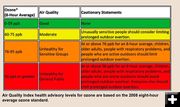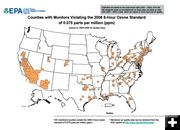

Ozone Table
This table shows what monitoring stations exceeded federal standards for ozone levels in Sublette County last week. The national standard is 75 ppb, so the numbers in yellow are times the levels were exceeded.
|


Health
This table summarizes the national Air Quality Index health advisory levels for ozone.
|


Ozone Map
This map demonstrates other areas around the nation that have failed to meet the federal ozone standard, using 2004-2008 air quality monitoring data.
|
|
Five days of ozone
by Cat Urbigkit, Pinedale Online!
March 8, 2011
Ozone levels in Sublette County exceeded national air quality standards for five days last week, according to real-time data recorded at monitoring sites administered by the Wyoming Department of Environmental Quality.DEQ spokesman Keith Guille cautioned that the monitoring site readings are preliminary and have not yet been quality-checked, but confirmed that yes, Sublette’s ozone is in non-compliance. Monitoring data indicates ozone levels reached the point deemed unhealthy for the general public on numerous occasions and locations in the county last week. Tuesday through Thursday saw elevated ozone levels, followed by a break on Friday, and elevated levels once again on Saturday and Sunday.
WHAT IS OZONE?
Ozone is generally considered to be an urban pollutant, and is the principal component of smog, often seen in summer months in large urban centers with industrial activities.
The Upper Green River Basin provides a unique scenario for the creation of winter ground-level ozone. Ozone appears to be elevated in this rural basin when there is a presence of ozone-forming precursor emissions (including oxides of nitrogen and volatile organic compounds) coupled with strong temperature inversions, low winds, snow cover, and bright sunlight. The geography of the basin means when an inversion sets in, and there is no wind, there is no way to disperse pollutants.
"It’s like having a lid over a pot, keeping it there," Guille said. In addition, sunlight has a dual effect when it is reflected off the snowcover present in the region this winter. Thus, last week, when an inversion set in, Sublette County had an unprecedented five days of ozone noncompliance in a single week.
HEALTH
Ozone is an air pollutant that can cause respiratory health effects especially to children, the elderly, and people with existing respiratory conditions. The Wyoming Department of Health advises that people in these sensitive groups should limit strenuous or extended outdoor activities, especially in the afternoon and evening.
Dr. James Quirk of the Pinedale Medical Clinic said the clinic is currently seeing a lot of patients with respiratory problems. "The cause-and-effect question is a difficult one," he said. "This is flu season. Are the upper respiratory tract infections we’re seeing because of ozone? I don’t know."
"Is someone’s flu lasting a few days longer because of the ozone situation?" Quirk asked, saying he’s not sure of the answer.
Regardless, Quirk said, members of the public should follow the advisories issued by the state.
"Stay in," he advised to those in sensitive groups. "If you have an upper respiratory infection, don’t go outside," Quirk said. "Be observant of the advisories."
DEQ’s Guille stressed that state-issued ozone advisories are released so that the public can make informed decisions for themselves. "These advisories are a way to provide all the information that we have to the public," Guille said, so individuals can make their own decisions about outdoor activities. Guille noted people should speak to their personal physicians or health experts about participation in outdoor activities during elevated ozone events.
Sublette County Public Health Officer Dr. J. Thomas Johnston said when the ozone levels become elevated to the extent it becomes being unhealthy for the general public, avoidance is the best policy. "Stay inside," Johnston said, adding that this caution goes out to all those involved in recreational or occupational activities in the outdoor. Affected members of the population, according to Johnston, include children using outdoor playgrounds, athletes participating in outdoor sports, and those who work in the outdoors, including ranchers feeding hay to wintering livestock herds, and workers in the energy industry.
The EPA reports that the potential health effects from ozone exposure is irritation to the respiratory system, causing coughing, throat irritation, and an uncomfortable sensation in the chest. Ozone can reduce lung function and make it more difficult to breathe, and can aggravate asthma.
Johnston noted that a recently released health risk assessment for Sublette County did not find ozone a long-term health risk for the county’s residents. Johnston said while ozone may affect certain people during periods of elevated ozone concentrations, in general such levels only occur three or four days each year.
"It is a very difficult process to address in view of the current land management policies" that allow winter drilling, Johnston noted, pointing out that ozone concentrations occur only in certain conditions in the basin. "It’s a winter phenomenon, usually occurring in late February and March," Johnston said.
NATURAL GAS
The natural gas industry uses the state-issued ozone advisories as a trigger to modify their operations to reduce emissions. Contingency plans are activated to reduce the ozone precursors. The action plans include short-term measures such as no idling of vehicles or equipment, minimizing the use of internal combustion engines, and limiting other activities that could increase emissions, according to information provided by Pinedale Anticline operators Ultra Petroleum, Shell and QEP Energy Company.
Shell spokesman Darci Sinclair, speaking on behalf of the companies said the operators "took steps to postpone work that was not essential for operations or for safety."
"We have hundreds of employees and contractors that live in this community who value air quality, too," Sinclair noted.
Sinclair provided a list of revised work actions by the three companies last week in response to elevated levels of ozone that exceed federal air quality standards. Shell temporarily shut down a workover rig, delayed some completions activities, and deferred a number of non-essential maintenance activities.
QEP postponed workover operations rigs and snow removal activities, in addition to deferring construction work, according to the memo provided by Sinclair. The company shut down a surface-hole rig, a cuttings pit solidification project, and halted other facility installations, in order to eliminate emissions from heavy equipment, diesel-fired engines, and welding activities.
Ultra reduced its construction crews by 80 percent, and scheduled fuel and materials delivery during evening hours to avoid the peak ozone periods, Sinclair noted. The company also minimized non-essential installation and maintenance activities, including snow removal.
DEQ REACTS
Late last week DEQ notified members of the natural gas industry in the Pinedale Anticline and Jonah natural gas fields that the agency will ramp up inspections of all major and minor emission sources, and planned to meet with industrial representatives to find out what more can be done by the industry to curb emissions during times the state issues its ozone advisories, according to DEQ spokesman Keith Guille. Those meetings began this week.
INDUSTRY MEETINGS
QEP Resources communications specialist Emily Kelley provided information about DEQ’s meeting with Pinedale Anticline operators on Monday.
"We all agree that we've made important progress in reducing emissions on the Pinedale Anticline, but everyone recognizes that across the basin there is still work to do," Kelley stated. "On the Anticline, we have already put in place a number of measures including liquids gathering systems, catalyst technology on multiple drilling rigs and controls on production facilities that have reduced nitrogen oxides and volatile organic compounds, which can be precursors for ozone formation.
"In addition to our long-term emission reduction activities, as well as our ozone contingency plans, we have identified some additional voluntary actions that we can take immediately to further reduce emissions through the end of this ozone season.
"Ultra plans to continue to suspend all completion operations that require flaring. In addition, they provide 100% recycled water to their completion operations via pipeline to reduce trucking and associated emissions. Lastly, Ultra continues to look at every facet of its operation to see where additional reductions can be made.
"Shell has agreed to suspend ongoing completions activities when an ozone advisory is issued, which they began immediately on Friday following an advisory that was issued for Saturday. That includes securing the well and shutting down hydraulic fracturing operations to reduce the associated emissions. Shell will keep a minimal crew on-site to ensure safety and well integrity and to prevent equipment from freezing while operations are shut down. This also eliminates emissions associated with the engines on the hydraulic fracturing trucks, trucking materials to the location for the completions activities, and transporting workers to and from the site. Shell will keep the approximately 70 workers that typically support these activities on standby in order to resume operations when the advisory ends.
"As part of their liquids gathering system, Shell also has a water distribution system to deliver produced water to their locations for completions activities. This not only reduces the use of fresh water, but also further reduces emissions associated with water delivery truck trips on the Anticline.
"QEP will continue to defer all completions until mid March, as well as shutting down all work-over rig operations not related to production maintenance.
Kelley concluded: "The reality, as we all know, is that no one can do this on their own. Everyone plays a role in improving air quality in our community. The ozone events last week occurred across the Upper Green River basin. DEQ is working diligently to review the data and all of the factors involved, which includes gathering additional monitoring data at the air monitoring stations to better understand why ozone occurs and how to better control its formation in the winter."
To check ozone readings at monitors located throughout the state, check out DEQ’s monitoring site by clicking on the link below.
|


